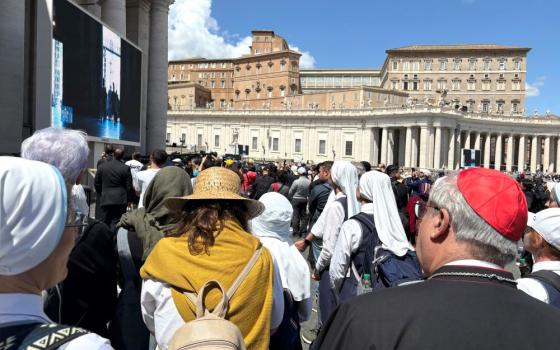
(Unsplash/Dominik Scythe)
I have purchased enough olive wood in support of the Holy Land over the years to sink a boat. But it was at an olive wood sale that I first noticed her, and knew she had to come home with me: a 14-inch olive wood statue of the Samaritan woman walking, balancing her jug on her head with one thick and sturdy arm.
She is a striking figure. Her face is neutral, lending the beholder no idea if she had just met Jesus or was yet to. There is no way to judge just how heavy her jug might be. All one can see is her movement; either hurrying toward Jesus or away from him.

Olive wood statue of the Samaritan woman (Courtesy of Sue Stanton)
She holds her clothing up enough for her bare feet to show, and my eye is drawn upward from her fingertips to the black grain running through the wood. It becomes a blended, dark, bruising landscape flowing the entire length of the front of her arm. I am afraid. I don't want to look at her anymore.
But I can't take my eyes off her to glance at the Blessed Virgin holding her child for consolation as I know this Samaritan woman doesn't belong here among the shepherds leaning on their sticks, carrying flutes, looking sleepy. Here stands Joseph, a father, a properly married man in a stable with cute, sweet animals helping them stay warm. None of this seems to fit next to this out-of-place, powerful woman; nor does she fit in with the wise men or wooden rosaries.
I am afraid to pick her up for a closer look, but I do — with both hands. I see and feel her for what she really is, standing alone and out of place.
Why didn't the artist cut out this obvious defect in the wood? It could be easily done. My husband carves pickles from wood every Christmas and has tools to take out such blemishes for a cleaner, purer, whiter surface. But no, on closer examination, the artist's will endured. Here is proof. What is medically called an "orbital blowout."
Art breaks us, shatters us, shakes us into a new realm of ideas.
The darkest point of the grain flows directly below her right eye, from inner to outer edge. A large surface of her face is black, covering cheekbone clean back to the ear. Her chin is dark; her face familiar; her eyes blank.
Now the words come back to me, "Go and call your husband." And when she confesses, Jesus says to her, "You're not lying to me. I know. You've had five husbands. And the man you're living with is not your husband either" (John 4:17-18).
What is her story? We do not know. But it is possible that it involved what we might today call sex trafficking, or slavery. It certainly involved suffering.
In 1999, St. John Paul II wrote in "Letter to Artists"
Society needs artists, just as it needs scientists, technicians, workers, professional people, witnesses of faith, teachers, fathers and mothers, who ensure the growth of the person and the development of the community by means of that supreme form which is "the art of education."
He later writes: "Every genuine art form in its own way is a path to the inmost reality of man and of the world." Art, he writes, "is therefore, a wholly valid approach to the realm of faith, which gives human experience its ultimate meaning."
Homilies on the Samaritan woman's conversation with Jesus leave us asking more questions. She feels almost completely misunderstood. Her conversation with Jesus seems to be part of a much larger conservation just beginning. After all, his companions arrive after being away for a long period of time. What would Jesus say to a woman he finds in this bruised and battered condition?
Advertisement
Art breaks us, shatters us, shakes us into a new realm of ideas; landscapes where spending a few moments take on many other possibilities.
Sacred art surprises, and in the eye of the beholder it has the capacity to strike a chord like a symphony in the heart. Some symphonies make us sad, others uplift our spirits, but both work in harmony to inform us of the complexity of life.
We need such art now. New voices, new perspectives, new eyes and ears. Art that enlightens, lifts and extends the essence of our faith spirit.
When you stumble upon an object that opens up God's world inside you, don't forget to thank the other helper involved. I hope the artist of my statue is doing well and has not given up on the holy moments that inspired their work.
Unfortunately, no artist can ever fully know just how much their creation works on the eye of a beholder. God willing, I pray and hope they will always persevere.




